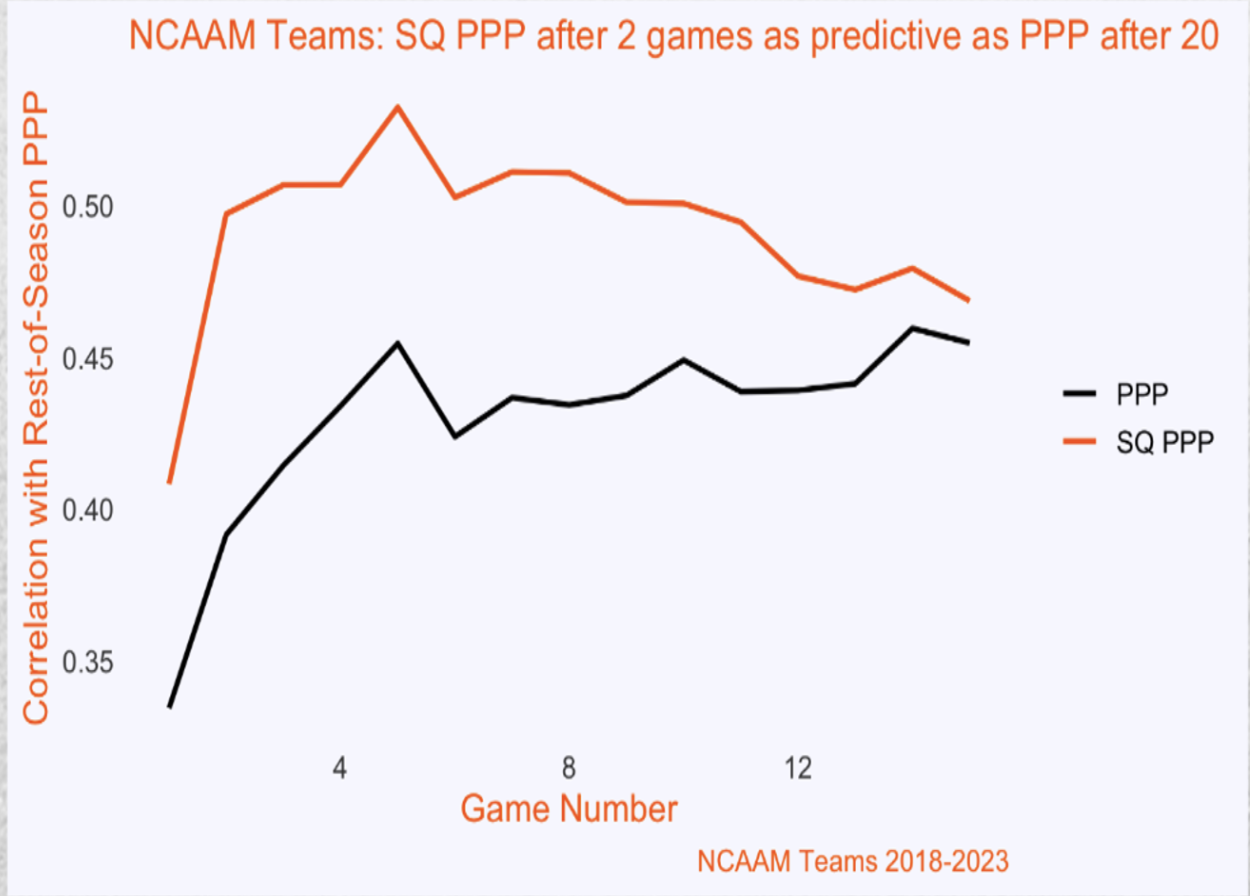
ShotQuality Points Per Possession: The Future of Expected Basketball Metrics
Posted at: 10/13/2023
In basketball, every shot counts, but not all shots taken are equal. As fans, analysts, or bettors, we’ve long relied on the final score as the definitive statement of a game’s outcome. But what if there was a more encompassing and predictive way to understand each game’s result? Enter ShotQuality’s revolutionary metric: ShotQuality Points per Possession aka SQPPP.

The Power of SQPPP: Fast and Focused Predictions SQPPP is no ordinary metric, for NCAAM teams, it can analyze a teams process and shot selection in just two games with the same precision that traditional PPP achieves in 20 games. On an individual player level, our metric needs only 5 games to reach the accuracy that PPP does in 20. ShotQuality assesses quality and decision making, which the traditional the box score does not.
At the end of the day, the highs and lows of basketball mean if you try to predict future performance on past PPP results, you will have much less success than if you use SQPPP because SQ accounts for the many factors that go into any given shot.
Cracking the Code: How Do We Calculate ShotQuality?
At its core, ShotQuality evaluates every shot’s potential outcome, or expected field goal percentage. By grading each shot on a scale of 0-100%, we calculate the probability of a shot going in. This percentage, when multiplied by the points attempted, gives us the ShotQuality value for that possession, which over the course of a game or season gives us the SQ Points Per Possession ratings.
But, it’s more nuanced than it sounds. Our methodology stands out because we consider individual player metrics. After all, a three-pointer from Steph Curry and Dwight Howard should have different expectations.
Real-World Examples: Let’s look at two NBA legends. Chris Paul, known for his midrange prowess, nails 55% of his elbow jumpers, translating to a ShotQuality EV of 1.10. In contrast, Russell Westbrook hits 35% from the same spot, resulting in a ShotQuality value of 0.70. Delving deeper, the differentiation between a two-pointer and a three-pointer is key. But the magic lies in computing the actual chance of a basket.
Parsing Luck from Skill with SQPPP One of the profound aspects of ShotQuality’s SQPPP is its ability to differentiate between skill and luck. Take, for instance, the case of a player like Steph Curry. There might be games where Curry only manages to score 15 points from shots that he would typically net 30 points off. At face value, many might jump to the conclusion that the opposing defense managed to stifle Curry. But with the nuanced understanding provided by SQPPP, a different story emerges.
It’s possible that Curry is still getting to his prime spots and is merely having an off day. Rather than viewing it as a declining trend, with the aid of our metrics, you’d recognize that Curry is primed for a bounce back in future games. This ability to parse luck from skill ensures that predictions and analyses aren’t just reactive, but proactive, anticipating the course of future games.
Model Insight: The Anatomy of ShotQuality
Our shot evaluation model is not just about numbers; it’s about depth. Over 90 variables weave into the ShotQuality value for every single shot, all extracted directly from video feeds using computer vision and AI. This granularity enables us to distinguish between genuine shot-making skills and a fortunate made shot.
From a player’s 3PT shooting ability, their prowess off-the-dribble, to even the percentage chances of an offensive rebound – we analyze it all. Our exhaustive list of variables ensures that when we talk quality, we mean it.
Assessing and Optimizing Lineups using SQ PPP:
SQ PPP isn’t just about evaluating individual players; it plays a pivotal role in understanding team dynamics. Consider a coach deliberating over which lineup of players to put on the court. There might be a combination of five players who, over a span of 4 minutes, create numerous open shots, yet miss most of them.
Traditional metrics might paint this scenario as ineffective. But SQ PPP dives deeper, evaluating the quality of those shots and the potential they had to score. The players might have been doing everything right, setting up open opportunities and playing to their strengths. With SQ PPP, coaches get a clearer picture, understanding that while the shots didn’t land this time, the lineup is effective and can deliver in the long run.
It becomes an invaluable tool in lineup optimization, ensuring that player rotations aren’t just based on surface-level stats but are backed by in-depth, location-based analysis.
Why Does This Matter?
It’s not just about understanding the game better; it’s about understanding it faster. With our location-based, AI-powered algorithms, ShotQuality offers a unique metric that outpaces any other. Whether you’re an analyst, a betting enthusiast, a fan, or someone deeply involved in team performance – knowing what’s likely to happen next, quicker than anyone else, is invaluable. So, why rely merely on the score when you can be ahead of the curve?
With ShotQuality, you can redefine how you see the game. It’s more than just numbers; it’s the future of basketball analytics.
Get the Latest from ShotQuality!
Stay updated with the latest news and analyses directly in your inbox.
Recent Posts
- WNBA Prop of the Day: August 24th
- WNBA Prop of the Day: August 23rd
- WNBA Prop of the Day: August 22st
- WNBA Prop of the Day: August 21th
- Justin's WNBA Picks Blog - 8/22
